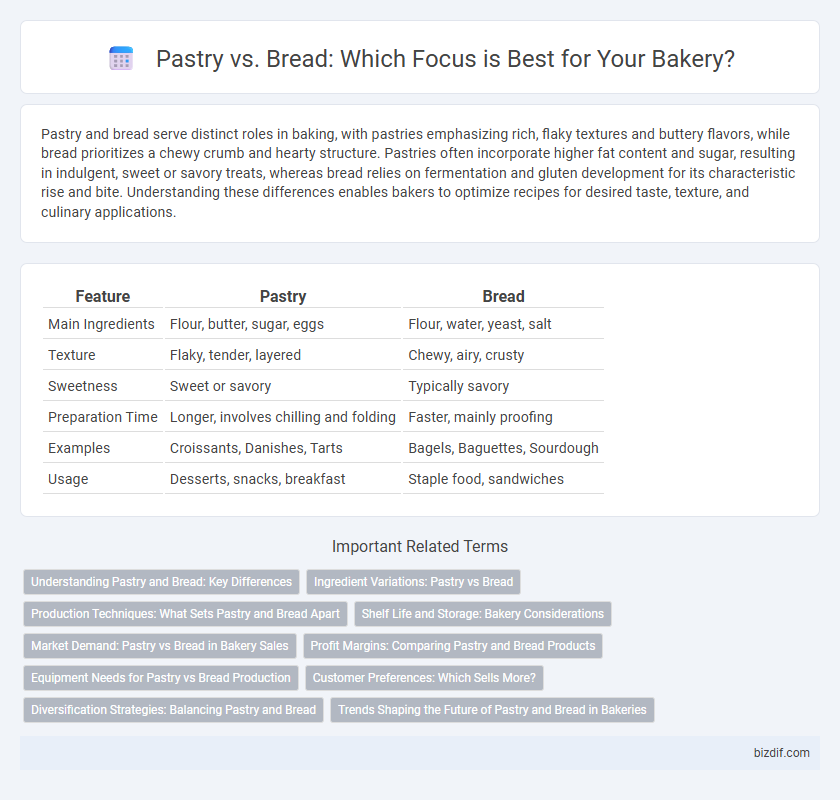Pastry and bread serve distinct roles in baking, with pastries emphasizing rich, flaky textures and buttery flavors, while bread prioritizes a chewy crumb and hearty structure. Pastries often incorporate higher fat content and sugar, resulting in indulgent, sweet or savory treats, whereas bread relies on fermentation and gluten development for its characteristic rise and bite. Understanding these differences enables bakers to optimize recipes for desired taste, texture, and culinary applications.
Table of Comparison
| Feature | Pastry | Bread |
|---|---|---|
| Main Ingredients | Flour, butter, sugar, eggs | Flour, water, yeast, salt |
| Texture | Flaky, tender, layered | Chewy, airy, crusty |
| Sweetness | Sweet or savory | Typically savory |
| Preparation Time | Longer, involves chilling and folding | Faster, mainly proofing |
| Examples | Croissants, Danishes, Tarts | Bagels, Baguettes, Sourdough |
| Usage | Desserts, snacks, breakfast | Staple food, sandwiches |
Understanding Pastry and Bread: Key Differences
Pastry and bread differ primarily in ingredients, texture, and preparation methods; pastries typically contain higher fat content, such as butter or shortening, resulting in a flaky or crumbly texture, while bread dough is usually leaner and produces a chewy, airy crumb. Pastries often involve techniques like laminating or folding to create layers, whereas bread relies on yeast fermentation for rise and structure. Understanding these distinctions is essential for bakers to achieve desired flavors and textures in each baked good.
Ingredient Variations: Pastry vs Bread
Pastries typically contain higher amounts of butter, sugar, and eggs, contributing to their flaky, tender texture and rich flavor, whereas bread focuses on simpler ingredients like flour, water, yeast, and salt, resulting in a chewier texture and less sweetness. The inclusion of fats and sugars in pastries alters the gluten development, creating a delicate crumb compared to bread's denser structure. Ingredient ratios significantly impact the final product's texture, moisture, and taste, distinguishing pastries from bread in baking techniques and sensory experience.
Production Techniques: What Sets Pastry and Bread Apart
Pastry production involves precise temperature control, layering of dough and fat through techniques like laminating to create flaky, tender textures, while bread relies on yeast fermentation, kneading, and proofing for structure and chewiness. Pastry doughs typically use higher fat content and shorter mixing times to avoid gluten overdevelopment, contrasting with bread doughs that require longer fermentation to build gluten strength. These distinctive production methods result in pastries that are delicate and crumbly, whereas bread achieves a firm, elastic crumb and crust.
Shelf Life and Storage: Bakery Considerations
Pastries typically have a shorter shelf life than bread due to higher moisture content and delicate ingredients like butter and cream, making them prone to staling and spoilage. Bread, particularly artisan or sourdough varieties, benefits from a longer shelf life when stored in airtight containers at room temperature, slowing mold growth and moisture loss. Proper storage techniques, such as refrigerating pastries to extend freshness while avoiding sogginess and keeping bread in breathable packaging, are critical for maintaining quality in bakery operations.
Market Demand: Pastry vs Bread in Bakery Sales
Pastry products, driven by rising consumer preference for indulgent and specialty items, show rapid growth in bakery sales compared to traditional bread, which maintains steady demand due to staple usage. Market data reveals pastries contribute to higher profit margins, with gourmet and artisanal varieties attracting premium pricing in urban markets. Bread sales remain consistent, supported by daily consumption patterns and expanding demand for whole grain and health-focused options.
Profit Margins: Comparing Pastry and Bread Products
Pastry products generally yield higher profit margins than bread due to the use of premium ingredients and the ability to command higher retail prices. Bread often relies on volume sales with thinner margins, benefiting from lower production costs and consistent demand. Bakers focusing on pastries can maximize profitability by targeting specialty markets and seasonal trends, while bread offers steady revenue streams in bulk.
Equipment Needs for Pastry vs Bread Production
Pastry production requires specialized equipment such as sheeters, molders, and temperature-controlled proofing cabinets to handle delicate doughs and intricate shaping processes, while bread production relies more on large-scale mixers, fermentation chambers, and deck ovens designed for consistent crumb structure and crust development. Precision temperature control and humidity management are crucial in pastry making to achieve flaky textures, contrasting with the robust kneading and proofing systems prioritized in bread production. Investing in the right equipment tailored to the unique requirements of pastries or bread significantly enhances production efficiency and product quality in bakery operations.
Customer Preferences: Which Sells More?
Customer preferences in bakeries often lean towards pastries due to their variety, sweetness, and convenience, making them a popular choice for breakfast and snacks. Bread sales remain steady, particularly artisanal and specialty loaves that cater to health-conscious consumers and meal bases. Market data shows pastries typically outperform bread in impulse purchases, but bread maintains strong demand for everyday staple consumption.
Diversification Strategies: Balancing Pastry and Bread
Effective diversification strategies in bakeries emphasize balancing the production of pastries and bread to cater to diverse customer preferences and increase market reach. Focusing on pastries attracts customers seeking sweet, elaborate baked goods, while bread offerings meet daily staple demands, ensuring consistent sales volume. Integrating both product lines enhances brand versatility and mitigates risks associated with market fluctuations in either category.
Trends Shaping the Future of Pastry and Bread in Bakeries
Artisanal pastries and sourdough breads are driving innovation in bakery trends, with consumers seeking unique flavors and healthier ingredients. The rise of plant-based alternatives and gluten-free options is reshaping product offerings, catering to dietary preferences and lifestyle choices. Advanced baking techniques and sustainable sourcing contribute to the evolving landscape, positioning both pastry and bread as staples in modern bakery menus.
Pastry vs Bread Focus Infographic

 bizdif.com
bizdif.com